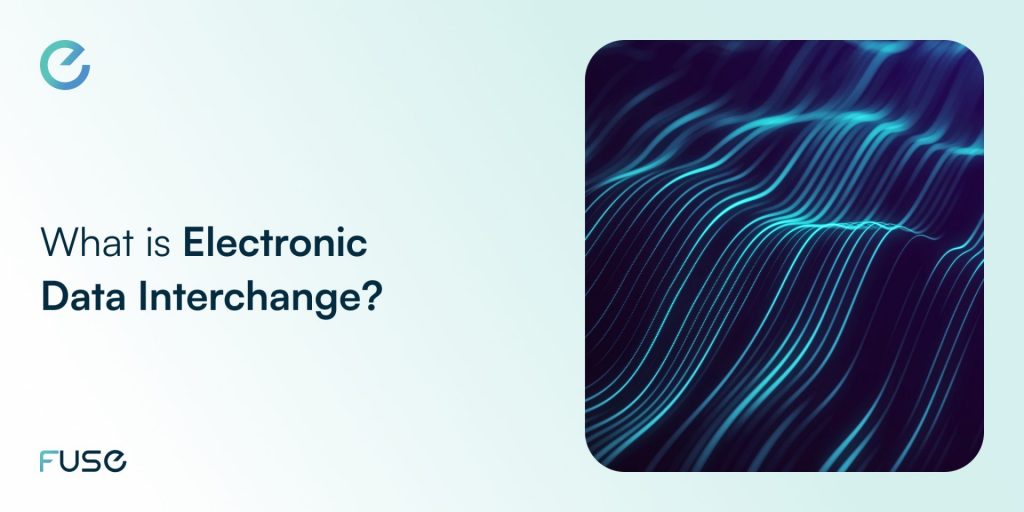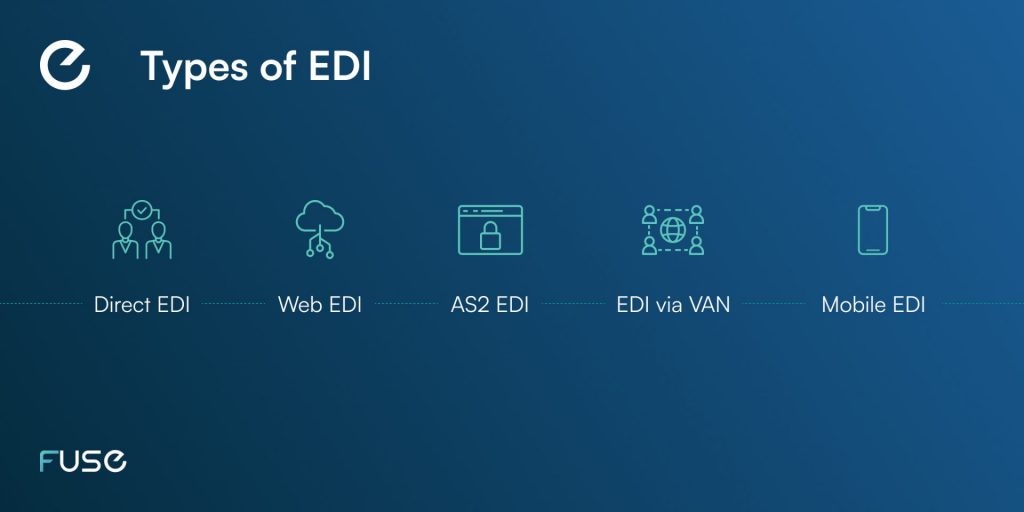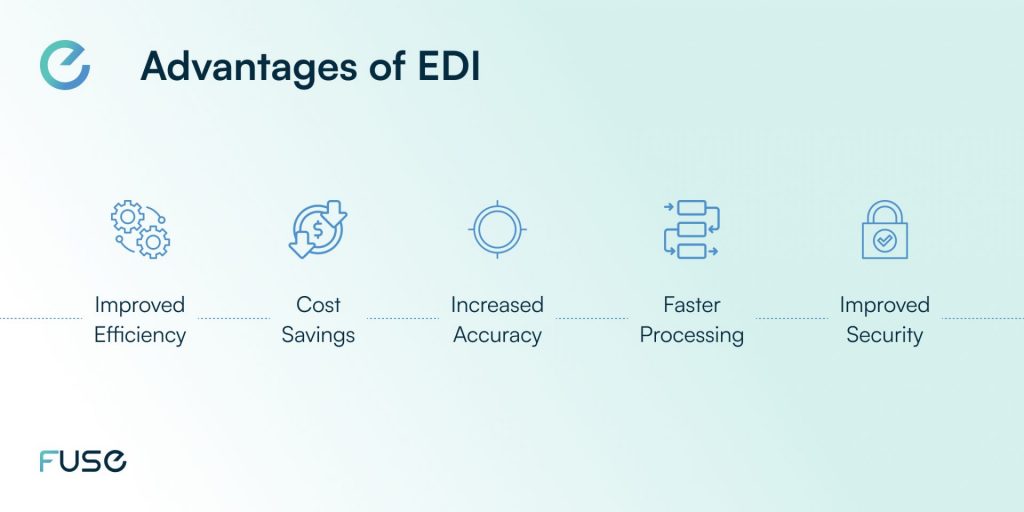What is Electronic Data Interchange?


Electronic Data Interchange, shortly EDI, is a computer-to-computer exchange of business documents between trading partners. It allows companies to remove postal mail, fax, and email from the equation and instead communicate with each other electronically, commonly through an EDI-enabled software application or platform.
Electronic Data Interchange Types
Electronic Data Interchange can be implemented in different ways, depending on the needs of the business. Among the most important types of EDI, we encounter:

1. Direct EDI
It involves a direct connection between the two parties exchanging data. Direct Electronic Data Interchange is popular between large organizations that have an ongoing business relationship and a high volume of transactions.
2. Web EDI
A type of Electronic Data Interchange that is accessible through a web browser. It allows smaller organizations to participate in EDI without having to invest in expensive software or hardware. Web EDI is great for lowering volume transactions and can be a good option for companies that don’t have the resources to implement direct Electronic Data Interchange.
3. AS2 EDI
AS2 (Applicability Statement 2) is a type of Electronic Data Interchange that uses a secure, point-to-point connection over the internet to exchange data. This type of EDI is often used for highly sensitive transactions, such as those involving financial or healthcare data.
4. EDI via VAN
A Value Added Network (VAN) is a third-party service provider that facilitates the exchange of Electronic Data Interchange data between trading partners. This type of EDI can be a good option for companies that don’t have the technical expertise or infrastructure to implement direct EDI.
5. Mobile EDI
With the rise of mobile devices, mobile Electronic Data Interchange has become an increasingly popular option. Mobile EDI allows users to access and exchange EDI data from their mobile devices, making it easier to stay connected and conduct business while on the go.
EDI offers many benefits to businesses, and the different types of Electronic Data Interchange allow companies to choose the approach that best suits their needs.
When deciding which type you should go for, you must consider factors such as the volume and sensitivity of the data being exchanged, as well as the technical expertise and resources available within your organization.
Why is EDI Important for Companies?
EDI is a method of exchanging business documents electronically. It’s a way for companies to streamline their processes, saving money and increasing efficiency as a result.
Electronic Data Interchange allows companies to exchange information about orders, invoices, and shipments without having to manually enter or update data in multiple systems. The outcome is that EDI reduces errors in data entry, improves customer service, and increases productivity by reducing manual tasks such as printing out forms or faxing them back and forth between offices.
What are the Advantages of EDI?
From reduced paperwork to improved accuracy and automated processing, many EDI capabilities are appealing to companies. We listed 5 of the most important benefits it brings along, regardless of the industry you’re in.

1. Improved Efficiency
EDI helps streamline business processes by automating data exchange between systems. As a consequence, there is no need for manual data entry, which saves time and reduces the risk of errors.
2. Cost Savings
By eliminating the need for paper-based transactions, EDI can save businesses money on printing, postage, and storage costs. It can also reduce the need for staff to handle the paperwork.
3. Increased Accuracy
EDI eliminates the need for manual data entry, which can reduce inaccuracies caused by human error. This leads to pinpoint data and fewer errors in business transactions.
4. Faster Processing
With EDI, data exchange between systems happens in real time, which speeds up business processes. This leads to faster order processing, quicker delivery times, and improved customer satisfaction.
5. Improved Security
EDI systems rely on secure protocols and encryption to protect data during transmission. This helps prevent data breaches and keeps sensitive business information safe.
Are There Any Downsides of EDI?
As most technologies do, EDI certainly has its challenges. Despite the cutting-edge security protocols and encryption, there is always a risk of a cybernetic attack since the data is transmitted electronically.
Then there are the high initial costs of implementing the technology, which might make it unattractive for smaller companies who don’t have the required capital to invest in software and hardware needed for an EDI system.
Another aspect is its complexity, since setting up and using an EDI system may require specialized technical knowledge. That is unless you don’t rely on software to do the heavy lifting for you.
And lastly, EDI’s lack of standardization, with different formats and protocols, might lead to interoperability issues.
How Does EDI Work?

Electronic Data Interchange (EDI) is a computer-to-computer exchange of business information in a standard electronic format. It’s an automated system that allows businesses to exchange data with each other electronically, eliminating the need to manually enter the same information over and over again into different systems.
In an EDI transaction, the sending organization creates an electronic document using EDI software and sends it to the receiving organization, which extracts the relevant data for processing. The data is then integrated into the receiving organization’s internal systems for further processing and fulfilment.
EDI can be used for all kinds of transactions but is used most commonly for invoicing or billing purposes. For example, when you buy something online from companies that use EDI technology, such as Amazon and eBay, they don’t have to send paper invoices in the mail. Instead, they send them electronically through their respective websites’ payment systems.
While used in many industries, EDI is often associated with supply chain management. EDI allows you to quickly share information about your products and services with your suppliers, customers, and partners, which means you can make better decisions about inventory levels and speed of delivery.
Companies look into EDI to automate their business processes. The final goal is to achieve enhanced customer service, reduce administrative costs, and increase accuracy while managing data.
Electronic Data Interchange Implementation
Implementing EDI involves multiple steps:
1. Identifying the business processes that will benefit from EDI. The first step is to determine which business processes EDI can improve. Common examples where EDI systems are useful include purchase order processing, invoice generation, and shipment tracking.
2. Selecting an EDI software or service provider. The next step is selecting an EDI software or service provider which corresponds to the organization’s needs. This may involve evaluating multiple vendors and comparing their features and pricing.
3. Mapping data to EDI standards. Before exchanging data through EDI, it must be mapped to the appropriate EDI standard. Such standards are ANSI X12, EDIFACT, and TRADACOMS. The mapping process involves defining the data elements and their positions within the EDI document.
4. Testing and certification. After the data has been mapped to the appropriate EDI standard, the organization must test and certify the EDI solution. This involves exchanging test documents with trading partners to ensure data is transmitted accurately and that the EDI solution works as expected.
5. Integration with internal systems. Once the EDI solution has been certified, it can be integrated with the organization’s internal systems for processing and fulfilment. This may involve configuring EDI interfaces with ERP systems, warehouse management systems, and other applications.
All things considered, implementing EDI requires careful planning and coordination with trading partners and service providers.
In the end, the benefits of EDI, mainly the faster and more accurate processing of business documents, can lead to significant cost savings and improved efficiency.
Rely on Fuse to Get the Most out of EDI
If you are looking for a platform to streamline your business document exchange process and improve workflow efficiency, then eTag Fuse will have your back.
The platform offers a range of Electronic Data Interchange (EDI) capabilities, allowing users to easily communicate information in a standardized electronic format. With Fuse’s built-in connectors and process automation engine, users can parse and generate different EDI files with ease.
Fuse offers connectors for various EDI formats, including X12, EDIFACT, and TRADACOMS and makes it simple to integrate EDI data with other systems and processes, creating a more streamlined and efficient workflow.
Additional Fuse Capabilities
Another great aspect of Fuse is that it offers EDI generation capabilities, which allow users to generate outbound EDI documents in various formats. This can be useful for sending invoices, purchase orders, and other types of business documents in a standardized electronic format.
With the process automation engine in Fuse, users can automate the generation of EDI documents based on certain triggers or events, such as the completion of a process or the receipt of a new order.
In addition, the EDI connector can be combined with the database connector to integrate EDI data with a database system. This can be useful for storing and accessing large volumes of EDI data in a structured format, allowing users to perform complex queries and analysis. Users can also use the EDI connector with the blob connector to store and retrieve EDI data in cloud storage systems such as Azure Blob Storage or AWS S3.
Whether you’re looking to integrate EDI data with other systems or streamline your workflow, eTag Fuse has you covered.
Our powerful platform allows you to easily automate your EDI workflows and exchange business documents in a standardized electronic format. Try it out today and take your business to the next level!
Contact us today to discuss how we can help your organization.

Sources

















